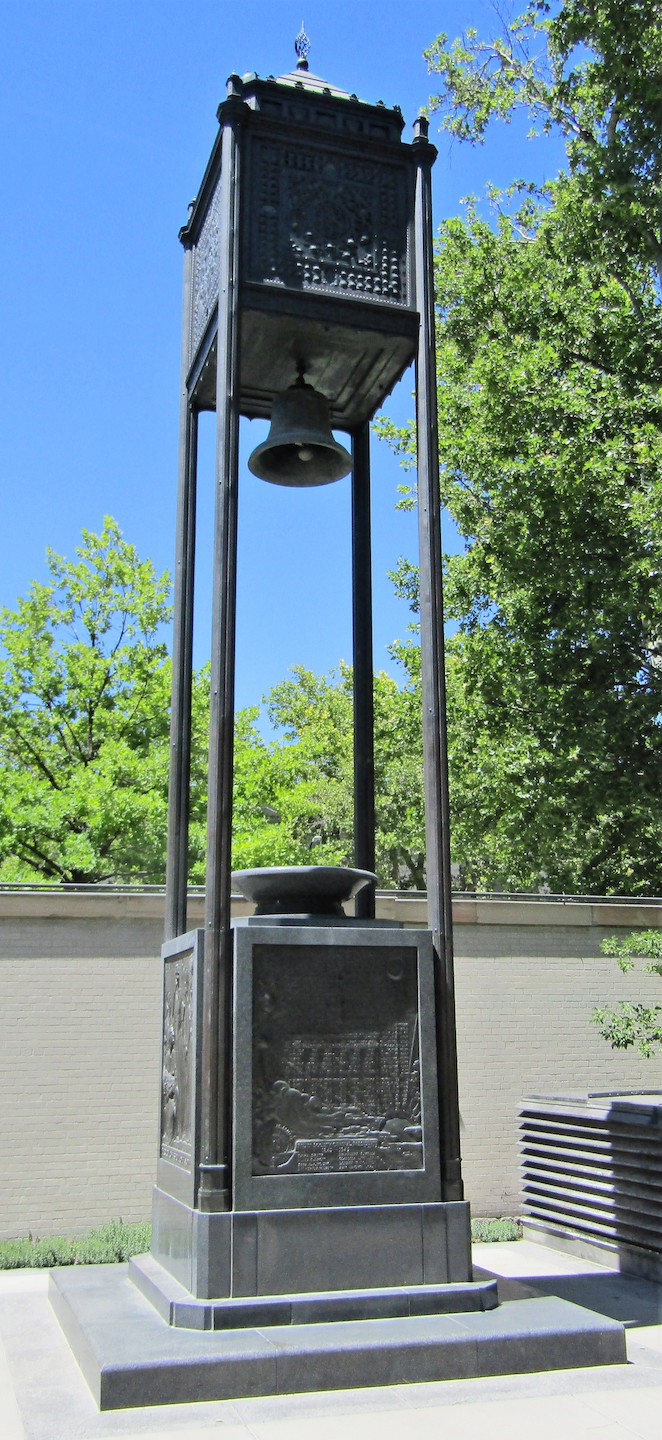Nauvoo Temple Bell
The Nauvoo Bell originally hung in the temple that Church members built in Nauvoo, Illinois, in the 1840s. The Saints removed the bell in 1846 when they were forced to leave Illinois because of persecution. Following instructions from Brigham Young, the company of pioneers led by Charles C. Rich were to carry the bell to the Salt Lake Valley. The bell resided for a time in Winter Quarters and left Winter Quarters on June 21, 1847. During their journey, they rang the bell to signal daybreak and departure and to warn that night sentries were on duty.
The Nauvoo Temple bell arrived safely in the Salt Lake Valley in mid-September 1847. “On October 2, it was placed in the original ten-acre log and adobe fort, next to the flagpole and not far from the brush bowery built by returning members of the Mormon Battalion. Three weeks later, Tarlton Lewis was paid one dollar to install a bell post and hang the bell.” Later, the Nauvoo Bell was moved to a new location near the old bowery on Temple Square.[1]
During the winter of 1849–50 the Nauvoo Bell cracked and was melted down. On September 14, 1850, the Deseret News reported the plans to enlarge and recast the bell.
The Nauvoo Bell Folklore
According to a descendant of Wilford Woodruff, the bell was donated by the British Saints for the Nauvoo Temple and sent to the United States in Woodruff’s care.
“In the late spring of 1845, nearly a year after Joseph’s death, the governing Quorum of the Twelve Apostles asked English members to consider contributing something substantial toward the construction of the temple. The request, signed by Brigham Young as quorum president and directed to British Mission President Wilford Woodruff, was to provide a bell for the temple.”[2]
However, according to [research] by Shannon M. Tracy, Glen M. Leonard, and Ronald G. Watt, funds were collected for the Nauvoo Temple—no longer a separate contribution for the bell—from the British Saints, and Brigham Young directed Woodruff to send the funds before he left England. Young now planned to purchase the bell in the States. Woodruff sent approximately £535 to the Temple Committee in Nauvoo by courier.
“A bell was secured and put to use in Nauvoo before Woodruff sailed from Liverpool in February 1846. If Woodruff had purchased an English bell, it could not have arrived in Nauvoo prior to mid-April 1846.”[3]
It is believed that shortly before the Lamoreaux family left Nauvoo for the West, “one stormy night the men gathered in secret and without horses pulled the wagon to the Church and lowered the Bell, pushed and pulled the wagon by hand to the edge of the Mississippi River and carefully concealed it in the water.” Andrew Lamoreaux and his brother, David, concealed the bell in their wagon with their provisions for the trek West.
However, the story of the Lamoreaux family hiding a bell in a river (actually a creek feeding the Iowa River) is connected to the Hummer bell. David Lamoreaux became involved in taking Michael Hummer’s bell from a Presbyterian church in Iowa City. At least four mean, including Lamoreaux, hauled the Hummer bell west, and David stopped in Salt Lake City in 1850. Lamoreaux may have been part of the negotiation with Asa Calkin, who clerked in the tithing office, for the sale of the bell to the Church.
- “The confusion over which bell came west with which emigrant company surfaces most often in accounts influenced by a series of next-generation Lamoreaux family histories. All of these stories borrow the details of the Hummer bell incident and apply them to the Nauvoo Bell. The first two of three interrelated Lamoreaux stories are biographical sketches based in part on an interview with David Lamoreaux. The first is a short, undated biographical sketch titled “The Nauvoo Bell.” It was written by one of David Lamoreaux’s daughters sometime after his death in 1905 and before 1943. Besides telling the Hummer story as if it took place in Nauvoo, this account brings the bell from England, changes Presbyterian to Methodist, and hangs the bell on Brigham Young’s schoolhouse. All of these errors are common elements in Utah accounts. ”[4]
In Salt Lake City, Brigham Young heard about the bell that Calkin had purchased in his absence and that it had once hung in an Iowa City church. Young asked Calkin to inquire about the bell and said he would purchase the bell or return the bell to the church if they wanted it back and could prove ownership. Young was unaware that Hummer owned the bell. Calkin’s inquires revealed that the ownership was not known. Hummer later became aware of the location of the bell and claimed ownership. Again, Young asked for affidavits certifying ownership. The issue remained unresolved throughout the rest of Brigham Young’s lifetime. The Hummer bell was never used by the Church of Jesus Christ and was transferred to the Deseret Museum in 1919.
Conclusion
The Hummer bell has been accepted by many since 1939 as the original Nauvoo Temple bell. In 1942 it was placed in a bell tower on Temple Square by the Relief Society to celebrate their centennial.
For the more expansive research of Tracy, Leonard, and Watt, see their BYU Studies article, “The Nauvoo Temple Bells”, which served as source for this brief article.
